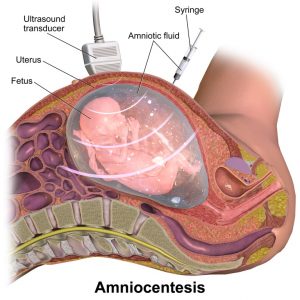Amniotic Fluid Definition
Amniotic fluid is the clear liquid that surrounds a developing fetus in the mother’s womb. It is formed from the mother’s plasma (or the fluid part of blood cells) as it diffuses past the fetal membranes and succumbs to the forces of osmosis and hydrostatic pressure.
Amniotic Fluid Overview
Visually speaking, the amniotic fluid will often have a yellow tinge, but it is always contained within an amniotic sac. The amniotic sac is the pouch that encloses the unborn fetus until its birth. The sac is made up of an amnion (inner) and a chorion (outer) membranes. Unborn babies are able to swallow or inhale the amniotic fluid before releasing it, as they have yet to breathe through their still-developing lungs which will require oxygen from the outside environment.
Amniotic fluid levels notably fluctuate during pregnancy, as well. The highest levels of amniotic fluid are present at the thirty-four-week mark with an average of eight hundred milliliters. On the other hand, at full term, or forty weeks of pregnancy, the amniotic fluid stands at around six hundred milliliters. Amniotic levels are important to maintain, as an overflow or underflow of amniotic fluid can render disease in the infant and/or mother, as discussed below.
What Does Amniotic Fluid Look Like?
Amniotic fluid is typically a clear liquid. Some leakage may occur during a normal pregnancy, as pressure is exerted on the amniotic membranes. This pressure increases with more than one baby, and women with twin or triplets are at a higher risk for a premature rupture of membranes. However, if the fluid is not clear it may signify problems with your pregnancy. You should consult a doctor if you are not certain about vaginal emissions during pregnancy.
What Does Amniotic Fluid Smell Like?
Unlike urine and other vaginal fluids, amniotic fluid has no distinct smell. Sometimes, the baby can severely increase the pressure on the bladder, causing some urine leakage. If discharge smells like urine, it is likely due to this increased pressure. Other smells can be the result of infection, and you should consult a doctor if you are concerned about discharge during pregnancy.
Amniotic Fluid Function
Like most conserved processes, there has been an evolutionary drive to conserve amniotic fluid in fetal development. There are few evolutionary processes as important as successful fetal growth. The importance of amniotic fluid lies in its functions.
The light, amorphous nature of amniotic fluid renders it the ideal medium for fetuses to move in. Motion is an essential part of the baby’s development as it encourages bone growth of the fetal limbs. Likewise, amniotic fluid envelops the fetus in a homeostatic environment where the temperature is constant and the fetus loses no warmth in the process. The liquid itself acts as a barrier between the fetus and its surroundings that effectively cushions the baby from external jolts or blows.
Another body system that benefits from the aqueous nature of the amniotic sac is the nascent respiratory system, specifically the lungs. Fetal respiration bypasses the lungs completely for the entire pregnancy, in favor of diffusing nutrients and gases between the fetus and the mother through the placenta. It will take nine months before the infant can expand its lungs to take its first breath. But in the meantime, the lungs are allowed to grow and their sensitive linings are kept moist by the surrounding amniotic fluid.
Amniotic fluid functions include:
- Fetal cushioning, or protection
- Maintenance of Homeostatic Conditions
- Fosters bone growth of fetal limbs
- Lung development within the fetus
Development of Amniotic Fluid
Origin of Amniotic Fluid
To better understand amniotic fluid, it is important to discuss its origin. The space that comes to hold the amniotic sac is chosen at the time of embryo implantation during the first week of pregnancy. This cavity fills with fluid even before the embryo can be identified, and the fill rate surpasses the growth rate of the embryo, initially. This fluid largely comes from the mother’s blood plasma.
In early fetal development, the volume of fluid increases linearly with the dimensions of the fetus. The water component of the amniotic fluid originates from the mother as it is pulled from her plasma. This is made possible by the bidirectional diffusion that takes place across the thin surfaces of the placenta or umbilical cord and the fetus’s skin, which has yet to harden with keratin. These thin surfaces are fully permeable to solutes and water.
During Gestation
Two months into gestation, the fetus begins to make urine once its urethra opens, and the infant also begins to swallow. These forces more or less oppose each other and therefore do not have a great impact on the sac’s volume. By week twenty, however, the fetus’s skin begins to keratinize. This is when the linear relationship between the size of the fetus and the volume of fluid stops. As the skin hardens, urine excretion begins to factor into the total volume of the amniotic sac, as does the efflux of fluid from the baby’s lungs and the reduction in his or her swallowing of fluid.
The actual composition of the amniotic fluid changes with the gestational stage. At the beginning of the pregnancy, the amniotic fluid will contain some electrolytes and water. But around the fourteenth week, the amniotic fluid will become rich in proteins, sugars, lipids, and urea. All of these are nutrients that aid in the unborn baby’s growth. For a long time, amniotic fluid was thought to be entirely made up of fetal urine. This idea has changed in recent times.
The consensus now is that amniotic fluid is a rich concoction of nutrients and growth factors that play a role in the infant’s growth and fosters antimicrobial protection.
Checking Amniotic Fluid
Obstetric physicians can take a sample of the fluid for early diagnostic purposes in a test called amniocentesis or AFT. Prenatal tests on amniotic fluid can reveal an infant’s sex, chromosomal abnormalities (i.e. Down’s syndrome), fetal infections, and test for amniotic fluid embolism. The latter results from having amniotic fluid or fetal debris enter the mother’s circulatory system, which poses a lethal threat to the mother as it triggers a massive autoimmune response.

The picture above depicts how Amniocentesis is performed.
Amniotic Fluid Disease
When the levels of amniotic fluid exceed the norm or are less than normal, this results in disease. Polyhydramnios is when there is too much fluid, a common occurrence for women who are carrying twins or triplets or if the baby has congenital defects. Too little is called oligohydramnios, and this results from having late pregnancies, placental defects, or a broken membrane. Of course, abnormal levels of fluid cause some alarm for obstetric physicians. Thankfully, an amniocentesis can reveal developmental abnormalities early on in the pregnancy.

The image is a histological slide of an amniotic fluid embolism, caused by the presence of fetal cells in one of the mother’s pulmonary arterioles.
Quiz
